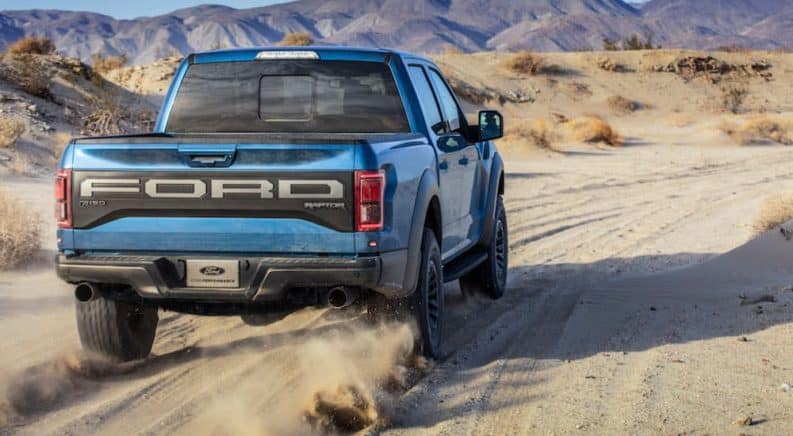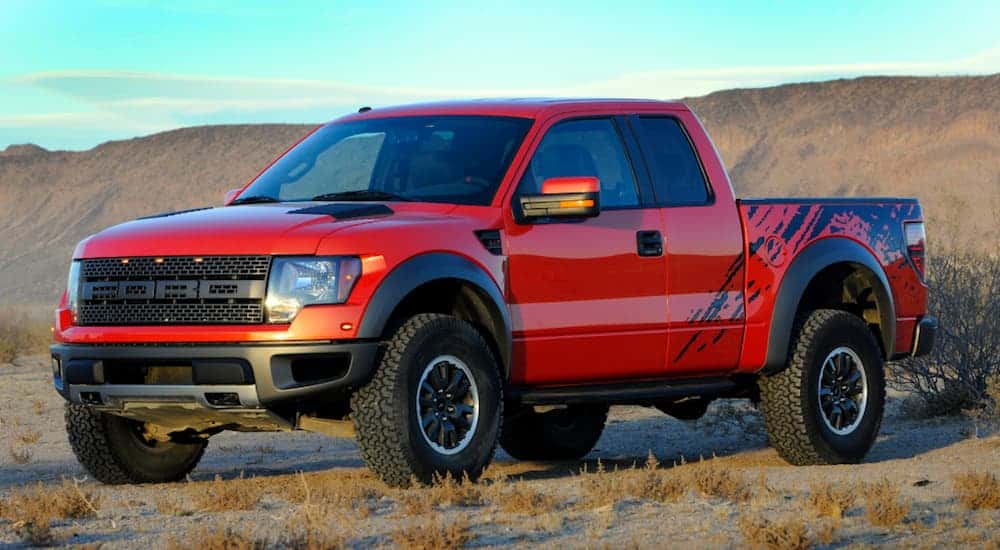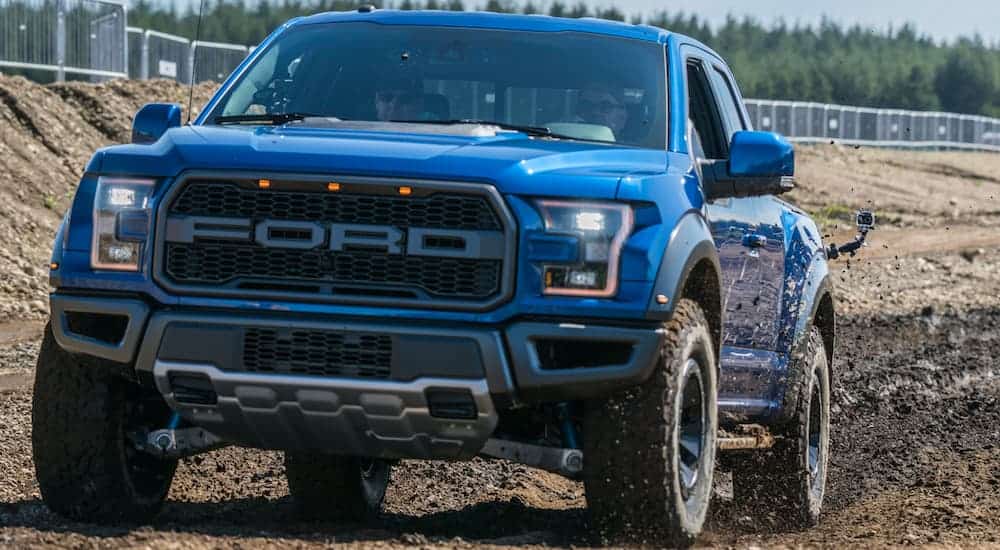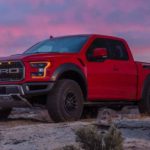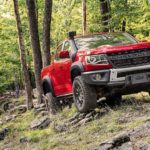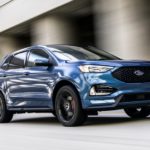The Ford F-150 was introduced to the American public in the 1976 model year, and since then, has become the best-selling vehicle for over thirty years running, making it one of the true success stories of the automotive industry, with new and used Ford trucks ruling the American roads. Perhaps part of the success of the Ford F-150 can be attributed to the detail Ford puts into the manufacturing of these vehicles. Over time, the specifications, engineering, and features of the F-150 have been modified and reimagined to keep up with the needs of the public. Since no two pickup truck owners are likely to have the same needs, Ford has introduced a variety of trim and added packages over the years that are intended to capture the needs of each segment within the full-size pickup truck market. The trims range from the bare bones, fleet-ready models to luxury models filled with all the bells and whistles, but one model stands out as the most rugged F-150 to date: the Ford Raptor. Production of the Raptor began in 2010, and since then, new and used Ford Raptors have gained an exceptional fan base who appreciate the vehicle’s versatility and truly tough design.
The First Generation of the Mighty Raptor
When looking at used Ford F-150 Raptors, it helps to know the differences between generations, and the variations that occur within each generation. The first generation came onto the market with immediate accolades, but that doesn’t mean Ford hasn’t worked to improve and redesign this fan-favorite over the years.
The first Raptor hit the streets in 2010, under the name “SVT Raptor.” The “Special Vehicle Team” replaced the “Ford Performance Division,” with the new moniker referring to the purpose-driven design of the line.
The SVT Raptor was based on the F-150, but was designed to be large, powerful, heavy-duty, and off-road-ready through and through. First-generation Raptors feature all-terrain tires, heavy-duty skid plates and shocks, and an electronic locking rear differential. Front fender and hood air extractors kept the massive vehicle cool under pressure, while interior features like leather seats and rear view cameras kept drivers cozy any time, anywhere.
2010 Raptors feature the F-150 SuperCab body, with a 5.4L V8 engine that offers 310 horsepower and 365 lb-ft of torque. A mid-year introduction added the option of a 6.2L V8, which offers a mighty 411 horsepower and 434 lb-ft of torque. Each engine is paired with a six-speed automatic transmission.
Ford paused production on the Raptor in 2014, thus ending the first generation; however, various changes helped build the brand throughout the first-gen. For example, in 2011, the 5.4L engine was removed as an option, but SuperCrew cabs were added to the menu. Some drivers felt this inhibited off-road action, while others appreciated the added versatility of higher payload and towing capacity, with an improved interior for driver and passenger comfort.
In 2012, Ford engineers explored improvements to the truck’s traction, handling, and overall driving experience with a helical gear limited-slip differential, which replaced the existing open differential. 2013 and 2014 were largely similar to their predecessors, though the 2013 edition introduced beadlock capable tires and HID headlamps, and 2014 saw the introduction of a brick red-themed Special Edition Raptor.
Second Gen: The Raptor Is Back Again
After a two year hiatus, the Ford Raptor was back in action. The second generation of the Raptor launched in 2017, every bit as massive, mighty, and off-road-ready as its older sibling. During their time off, it appears Raptor engineers worked to add modern technological convenience to the rugged backwoods-ready truck that had captured the heart of America with its first generation.
First came the rehaul of the overall body. First-generation Raptors are all steel, while second-generation Raptors feature a significantly lighter aluminum body, saving 500 pounds of road weight, and enhancing overall performance. The appearance of the second-generation is overall more aerodynamic, with more chiseled lines and less boxiness, though its big and bold stance hasn’t diminished at all.
Starting in 2017, Ford Raptors gained a 3.5L EcoBoost twin-turbo V6 engine that offers 450 horsepower and 510 lb-ft of torque, which is paired with a 10-speed automatic transmission. Electronic steering takes over for the first-generation’s hydraulic steering model. Wider Fox shocks add two inches to the suspension, and six driving modes allow the Raptor to perform according to the terrain and environmental challenges.
There are, of course, additional optional features that appeared on the truck market during that two-year gap, including the Ford SYNC3 system, rear camera technology that assists with hitching and towing, heated seats and steering wheel, WiFi hotspots, and Sirius XM Radio.
Comparing Generations
Because of their hardcore offroad presence, used Ford F-150 Raptors are often a popular choice for drivers who look to the mud, the forest, the mountains, and the desert for fun. For some, though, it might be hard to choose which year is best for their needs, however, especially since all Raptors are designed to be battle-ready behemoths.
There are a few differences to keep in mind when investigating used Raptors. As with all used trucks, the overall mileage is often less telling than how the truck was used. As a vehicle specifically designed for off-roading, used Raptors will probably show signs of their purpose, including scratches, dents, and light mangling from taking boulders, mud, and sand head-on. That being said, any physical defects should be examined for rust potential or the possibility of inhibiting the mechanical operation of the truck.
Comparing each generation side-by-side allows used Raptor shoppers the chance to see the subtle, yet important differences between the two. For example, while the first generation Raptors offered a choice between a 5.4L V8 and the 6.2L V8 engine, the latest generation offers only the 3.5L twin-turbo V6. While the current engine results in greater torque and horsepower, some drivers might not require that level of power, given their off-road goals.
The price tag is a large consideration as well. While it’s hard to predict how much a used vehicle will cost, shoppers will want to bear in mind historical price factors, including original MSRP, as well as the addition of any towing, appearance, or special packages.
Other standard factors include the change in ground clearance, from 9.3 inches to 11.5 inches in the second generation. While the curb weight has lowered by around 500 pounds, towing capacity is unchanged at 6,000 pounds for the SuperCrew models, and 8,000 pounds for the SuperCab models. First-generation Raptors have a combined fuel economy of 13 mpg, while second-generation Raptors get 16 mpg combined.
Bringing Home A Used Ford Truck
When shopping for a used Ford truck, the F-150 is an almost automatic go-to for many pickup truck drivers. For those who crave adventure off the beaten track and far from paved roads, the Ford Raptor might be a tantalizing option. Shopping for a used Ford Raptor can yield results that look similar without being the same, so approach the experience armed with as many details about the model’s history as possible. This information will help shoppers gain insight into the many differences and similarities between generations, and as a result, help you find the best value and experience for your money and needs.

